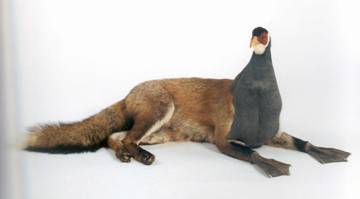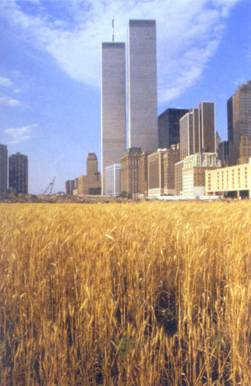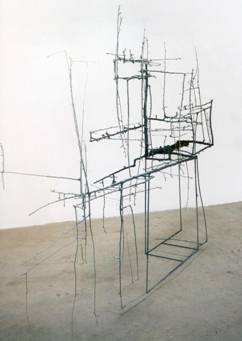ISSN: 1705-6411
Volume 6, Number 2 (July, 2009)
Author:Victoria Z. Alexander
I. Introduction
Judith Collins is a Senior Curator of Twentieth Century British Art at the Tate, London who has written several books and catalogues concerning modern and contemporary art. This book (which runs just under 500 pages and as many images), is a valuable assessment of sculpture at the present moment. Collins understands that the “contemporary” period begins in the 1960’s and I think this wise as a fifty year survey is required to understand the diverse use of materials and concepts in sculpture today. One impression the book generates is that if we had the best book on sculpture since the 1960’s sitting beside a book concerning the best painting since 1960 – the more vital art works would be contained in the sculpture book. This too is the story of the past half century – the century in which sculpture, due in no small part to its diversity, surpassed painting as the dominant art form in the West (and arguably, around the globe).
Collins divides her subject into eighteen chapters which look at the development of new sculptural ideas in a variety of areas (the figure; the body fragmented; strange creatures; post-pop objects; architecture and furniture; cultural diversity; traditional materials in the contemporary; ephemeral effects; works inspired by nature, colour, space, and light; memory; clothing; monumentality; installation; gravity’ size and scale; accumulation; and minimalism. The book contains a biography for each artist, a chronology, bibliography and an index. It is a large but not unwieldy book.
Collins also steps back further to assess the role of Duchamp and others in influencing the sculptural changes which began to emerge in the 1960s-70s. She points specifically to Duchamp’s The Mile of String (actually three miles) installed in new York in 1942. What Collins fails to challenge is some of the horrid art that derived from presumed Duchampian ideas such as Arman’s Le Plein (1960) which consists of a room full of household waste which for all the world looks just like a room of household waste. As Baudrillard pointed out on numerous occasions the problem with the aestheticization of everything (including trash), is that we get such attempts to make the banality of everything sacred. What is worse, it is an effort to pull art into reality when art’s entire existence is premised on it not mirroring the real (Baudrillard, 2005:105). I also wonder why, in her introduction, she does not refer to Robert Smithson’s Pour or Richard Serra’s Splash pieces s these were among works which fundamentally altered our conception of sculpture. Perhaps a bias has crept in which sees these works as too painterly today?
II. The Works
Collins chapter on the human figure gathers the usual suspects (Duane Hanson, George Segal, Mark Wallinger, George Baselitz, Evan Penny, Kiki Smith, Anthony Gormley etc.,) but also presents images of recent works by Mathilde ter Heijne, Belinde der Bruyckere, Gavin Turk, Paul McCarthy, Zhang Dali and others. While Collins tends to be more promotional than critical there is a good deal of evidence in this chapter which could lead one to conclude that while it is more diverse than ever before in its history, sculpture involving the human figure really isn’t all that interesting as we enter the 21st millennium.

1. Sarah Lucas. Bunny (1997)
1. Sarah Lucas. Bunny (1997)
Fragmentation of the body is a much more interesting development in sculpture and in recent years gallery goers have become accustomed to bodiless legs protruding from walls, heads hanging from ceilings Bruce Nauman’s Ten Heads Circle / In and Out (1990), or Isabel De Obadia’s Fragments of Warriors (2002). What Collins does not mention is that the works of fragmentation are among the more important sculptures being produced in recent years in exposing the monstrosity of the social and its seemingly effortless move into a permanent state of war. Work’s like Sarah Lucas’s Bunny (1997) point to the ongoing gender warfare which often sees women’s bodies equated with things and similarly used and discarded as they age. Lucas’s sculpture is also a fragmentary echo of Helmut Newton’s worn out Playboy Bunny (1975) with her cigarette and bent bunny ears.
Collins chapter “Strange Creatures” reminds us that in an era of so much visual science fiction just how accustomed to strange life forms we have become. Sculpture shows us that we have more in common with the age of myth and minotaurs (Thomas Grϋnfeld’s Misfit, 1990), than with classical or modern sculpture. Paloma Varga-Weiz’s Bumpman Sick (2002) could be a character in any number of later Star-Trek episodes.

2. Thomas Grϋnfeld. Misfit (1990)
2. Thomas Grϋnfeld. Misfit (1990)
The representation of strange and hybrid life forms is an especially imaginative aspect of contemporary sculpture and one that parallels disturbing trends in the life sciences. We are very close to the knowledge of genetics that would make Grϋnfeld’s creature (or something along these lines), possible within a few years. Paul McCarthy’s Spaghetti Man (1993) provides a nice resonance to hundreds of years of phallocentricity in the arts while Jake and Dinos Chapman’s Zygotic Accelleration (1995) illustrates our fears concerning cloning. One aspect of strange life forms not included in this chapter are art works by North American aboriginal shamans whose work sometimes represents the moment of the merging of the spirit of the animal and the shaman (for example the work of Lawrence Beck in Canada or any number of spirit masks makers).
The chapter on Post Pop Objects shows and discusses some of the more banal sculpture which has appeared in recent years from Jeff Koon’s Three Ball Total Equilibrium Tank (1985) through Tony Cragg’s Canoe (1982), Allan McCollum’s Over Ten Thousand Individual Works (1988), Katharina Fritsch’s Display Stand With Yellow Madonnas (1989), and Tobias Rehberger’s One (1995). In Mathieu Mercier’s Glad (2003) we are reminded not only of Warhol but of his crisis of creativity in the late 1980’s. In his diaries he wrote: “Went to the Whitney, I was there to ‘advertise’ my Campbell’s Soup Box painting. We must be getting desperate. Me standing there twenty years later and still with a Campbell’s soup thing, it felt like a New Yorker cartoon” (Warhol, 1987:681). Baudrillard’s term for such work was “inauthentic simulation” (Baudrillard, 1997:10) and this chapter reaches its high water mark with it!
Architecture and furniture is a chapter which provides many examples of the levels of banality to which contemporary sculpture [and furniture making] have descended. Why Olafur Eliasson (who often works with architects) was left out of this chapter is a complete mystery to me. One thing this chapter does very well however is to illustrate just how far from the concept of beauty sculpture has moved.
Cultural Diversity is a much better chapter including the thoughtful work of Fred Wilson (Guarded View, 1991), Pepan Osorio (The Bed, 1987), Willie Cole (Speedster, 2002), Brian Jungen’s Prototype for a New Understanding (1998), Anne Hamilton’s Myein (1989), and George Adeagbo’s The explorer and the explorers confronting the history of exploration! (2002). In many ways this enormous work (of over 1500 pieces) could stand in for the entire chapter which points to new ways of exploring the presence of those who conspicuous in sculpture for so long mainly by their absence. Many of the works appearing here not only problematize globalization but also the use of traditional (Western) materials.
Sculptors still work with traditional materials and the chapter examining these works includes Joseph Beuys’s The End of The Twentieth Century (1985) [basalt, clay and felt]; Richard Long’s Red Slate Circle (1988); Stephen Cox’s work with porphyry; Iran do Spirito Santo’s work with granite; as well as those who work with wood (Carl Andre, Ursula van Rydingsvard, Richard Deacon); steel (Anthony Caro); clay (Anthony Gormley); bronze (Mark Manders); and glass (Dale Chihuly).

3. Dale Chihuly. The Sun (2006)
3. Dale Chihuly. The Sun (2006)
The chapter: “sculptures which produce ephemeral effects” shows how we rely on video and photography for the re-presentation of such works. Media used here include fire (Jannis Kounellis), water (Roman Signer), food (Mario Merz, Anthony Gormley, Janine Anthony), flowers (Anya Gallaccio), insects (Damien Hurst), live animals (Xu Bing), and fireworks (Cai Guo-Qiang). So many of these transient works, especially those which depend on decay to function, point to the fragile nature of contemporary existence and address the monstrosity of our culture of waste. Collins points out that such works also point to the presence of chance in our lives and depend upon it themselves for their uncertain completion. Collins does not point out however that some of these works disappear as art not only because of their ephemerality but because they come too close to the real.
Art inspired by nature is an important aspect of contemporary sculpture. Perhaps the most ironic image in the entire book is a photograph of Agnes Denes Wheatfield – A Confrontation (1982). Denes’s wheat was planted in battery park just two blocks from Wall Street and the World Trade Centre. In 2001 this work took on a powerful added retroactive meaning as the solid, once again, melted into air. Joseph Beuys and James Terrell are not surprisingly here but one wonders where are the works of Olafur Eliasson and why is Andy Goldsworthy so downplayed in this chapter?

4. Agnes Denes. Wheatfield – A Confrontation (1982)
4. Agnes Denes. Wheatfield – A Confrontation (1982)
“Colour, Surface and Light” features Judd, Stella, Chamberlain, Fritsch, Kapoor, Laib, Flavin and a host of brilliant artists. Eliasson’s The Weather Project (Tate Modern, 2000) appears here as do many others which serve to raise the awareness of ourselves as perceivers and the role that changing light plays in this fundamentally human process. The next chapter Memory contains numerous of the most banal works in the entire book. Damien Hurst’s The Physical Impossibility of Death in the Mind of Someone Living (1991) captures the essence of this chapter which at best is about the transience of all aspects of the physical world but in the end, if this sculpture is representative of memory then I must say that it shows only that our memory is full of visual pollution. That may be the point of the chapter however but Collins will not leave the promotional long enough to force such an assessment to the ever “neutral” pages of this book.
Among the more interesting developments in sculpture in recent times is the subject of the chapter on clothing. While women dominate this category there are many strong works by men in recent years here including Erwin Wurm, Charles LeDray, and Joseph Beuys. Canadian Jana Sterbak’s Vanitas; Meat Dress for an Albino Anorectic (1987) is the strongest work in the chapter although it might have been better placed among the other works in the chapter on works which produce ephemeral effects. Perhaps the longevity of this salted work earns it its place among clothing although if you have ever been in its presence you will notice it possesses a particular smell. It is an interesting work and that is something that one cannot always say of contemporary sculpture.

5. Jana Sterbak. Vanitas; Meat Dress for an Albino Anorectic (1987)
5. Jana Sterbak. Vanitas; Meat Dress for an Albino Anorectic (1987)
So whatever happened to sculptural monumentality? The chapter on this subject harvests an embarrassing array of oddities which are located as much in the culture of the “experience industry” than in art. Here works such as Paul McCarthy’s Vinyl Coated Fabric Inflatable (2003), [over 100 feet high]; Olaf Metzel’s 13.041981 (1987); and Jeff Koon’s monstrous floral arrangement Puppy (1992) stray so far into the banal worlds they mimic that one cannot tell the difference. Art always dies in the real where it loses a sense of purpose. Still, this chapter contains many strong works of monumentality including Richard Serra’s Tilted Arc (1989), which eventually fell to the right wing art-death squads in 1990’s America; Anthony Gormley’s posthuman Angel of the North (1998); Rachel Whiteread’s Untitled [house], (1993); and Maurizio Catalan’s Untitled (1999), [a granite slab which records 148 English international football matches all of which England loses]. Monumentality was probably never better problematized in the postmodern than by Braco Dimitrijevic’s 11 March – This Could Be A Day Of Historical Importance (1979) which still stands in the gardens of Charlottenburg Castle in Berlin.
The chapter on installation is among the more interesting in the book as it covers many of the more important developments in sculpture’s problematization of the museal space in the contemporary period including Martin Creed’s empty gallery space where the lights go on and off, Michael Elmgreen and Ingar Dragset’s Suspended Space (2002), and Fabrice Gygi’s Palissades (2001) [a chain link fence blocking movement through the gallery]. The decision to leave Joseph Beuys and Ann Hamilton’s work out of this chapter does however boggle the mind. One gets the impression that Collins was left very much to her own devices in constructing this book when, despite her powers, more editorial assistance would have made for a stronger work.
Contemporary sculpture often challenges our conception of gravity and there is a particularly insightful chapter on this subject by Collins. Rebecca Horn’s Concert For Anarchy (1990) [which hung a piano upside down], Chris Burden’s The Flying Steamroller (1996), and Nancy Rubins Chas’ Stainless Steel (2001), are among the more impressive developments in using the gallery space to show how art can connect with concealed energy. Cornelia Parker’s Cold Dark Matter: An Exploded View (1991), and Maurizio Catalan’s Novacento (1997), are among the stronger works presented here which problematize mass in the gallery space. Parker’s work is perhaps the most discerning single work in the past decade to arrest the spirit of uncertainty today.

6. Cornelia Parker’s Cold Dark Matter: An Exploded View (1991)
6. Cornelia Parker’s Cold Dark Matter: An Exploded View (1991)
The final three chapters present sculptures which deal with “size and scale”, [a lackluster series of developments to be kind]; “accumulation” [mostly garbage forced to stand in for art]; and “minimalism” which rehearses numerous widely know works. The final image in the book [Evan Holloway’s Grayscale (2000) however represents so much of what contemporary sculpture has become: its ephemerality, reliance on simple materials, subdued tonalities, arrangement on the floor without a plinth, and frequent mergers of the natural and human-formed. This work powerfully establishes that for all the flotsam that floats into our galleries, it is all, after all, worthwhile when a work of such subtly and grace arrives.

7. Evan Holloway. Grayscale (2000)
7. Evan Holloway. Grayscale (2000)
III. Conclusion
Collins does more than a good job of selecting and showing a broad array of developments in sculpture over the past fifty years. Never before in art was the gallery space so subject to the manipulation of artists and their works. The world of contemporary sculpture is one in which the children and grandchildren of Marcel Duchamp (as well as those who reappraise his import), run amok – much to our pleasure and displeasure both. For all of its banalities and errors in judgment the world of contemporary sculpture will remain one of the most interesting aspects of an art world deeply at odds with itself for many years to come. Collins book shows us that today nothing can be ruled out as art but she needs to go further to demonstrate the problem this presents to art. Why is it that leading curators have gone over almost entirely to a position akin to advertisers? Can art no longer stand up to harsh scrutiny? Is there a fear, well justified perhaps, among art publishers and curators, that art really has ended? As this book shows, despite itself, there is little to worry about because after the end of art, there is always at least a little more art. That has not changed for a very long time.
About the Author
Victoria Z. Alexander is from Strasbourg, France.
References
Jean Baudrillard (1997). Art and Artefact (Edited by Nicholas Zurbrugg). London: SAGE.
Jean Baudrillard (2005). The Conspiracy of Art (Edited by Sylvere Lotringer). New York: Semiotext(e) / MIT.
Andy Warhol (1989). The Andy Warhol Diaries (Pat Hackett, Editor). New York: Warner.